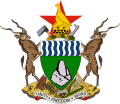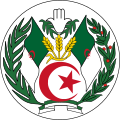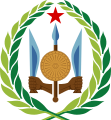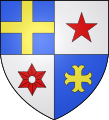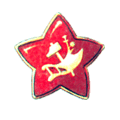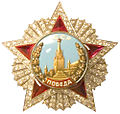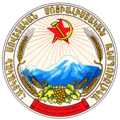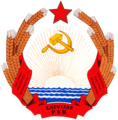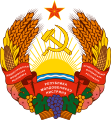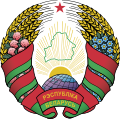Red star

A red star, five-pointed and filled, is an important ideological and religious symbol which has been used for various purposes, such as: state emblems, flags, monuments, ornaments, and logos.
Flags
-
Flag of New Zealand
-
Flag of Canton of Valais, Switzerland
-
A 1912 variant of the US presidental flag
-
Flag of Washington, D.C.
-
Flag of Panama
-
Flag of North Korea
-
Flag of Council for Mutual Economic Assistance (Comecon)
-
Flag of Red Star Line
-
Flag of the Chief of Staff of the Royal Italian Army[citation needed]
-
Flag of the Red Star Belgrade
Orders
-
Gallipoli Star (Ottoman Empire) (1915)
-
L'insigne des blessés militaires (France) (1915)
-
De Orde van Liefdadigheid Osmaanse Rijk (1878)
-
Patriotic Women's Association merit badge (Japan)
Architecture and stained glass windows
-
Rockefeller Chapel – University of Chicago stained glass closeup
-
US National Christmas Tree Washington, D.C.
-
Five-pointed star Oscar Fredriks kyrka, Sweden, (1893)
-
Stained glass windows in Berlin, painter Walter Womacka
Heraldry
-
Coat of Arms of New Zealand (1956)
-
Coat of Arms of Zimbabwe (1981)
-
Blason Pierre de Lannoy 1445 – 1510
-
Coat of Arms of Algeria (1971)
-
Coat of arms of Djibouti (1977)
-
Coat of arms of Blason ville (Puy-de-Dôme)
-
Coat of Arms of Minas Gerais' State, Brazil
-
Coat of arms of Fontanella, Austria
-
Coat of arms of Tunisia
-
(1918) Coat of arms I Squadriglia Caproni
-
Coat of arms of de:Kaulsdorf (Saale)
Symbol of Socialism and Communism
The five-pointed red star, a pentagram without the inner pentagon, is a symbol of socialism as well as communism. It is sometimes understood to represent the five fingers of the worker's hand, as well as the five continents. A lesser known suggestion[citation needed] is that the five points on the star were intended to represent the five social groups that would lead Russia to communism: the youth, the military, the industrial labourers, the agricultural workers or peasantry, and the intelligentsia. It was one of the emblems, symbols, and signals representing the Soviet Union under the rule of the Communist Party, along with the hammer and sickle. The symbol is currently banned in some countries as a symbol of a totalitarian ideology, and identified in other countries with antifascism and resistance against Nazi occupation. In the Soviet heraldry the red star symbolized the Red Army and the military service as opposed to the hammer and sickle which symbolized the peaceful labour.
-
Red star, Red Army 1918
-
Red Cavalry poster with budenovka, 1920
-
Coat of arms of the Latvian Socialist Soviet Republic (1919–1920)
History
The star's origins in a mass political movement are found in the Russian civil war and the end of the First World War, though its creator is unknown. It is most often thought that Russian troops fleeing from the Austrian and German fronts found themselves in Moscow in 1917 and mixed with the local Moscow garrison. To distinguish the Moscow troops from the influx of retreating Russians the officers gave out tin stars to the Moscow garrison soldiers, to wear on their hats. When those troops joined the Red Army and the Bolsheviks they painted their tin stars red, the color of socialism, thus creating the original red star.[1] Another claimed origin for the red star relates to an alleged encounter between Leon Trotsky and Nikolai Krylenko. Krylenko, an Esperantist, was wearing a green star lapel badge; Trotsky enquired as to its meaning and received an explanation that each arm of the star represented one of the five traditional continents. On hearing this, he specified that a similar red star should be worn by soldiers of the Red Army.[2] In a speech given by Trotsky in 1923, he mentions the red star:
For the seventh time since the overthrow of Tsardom, for the sixth time under the sickle and hammer of the Soviets and the Red star of battle[3]
And the badge was used in the Red Army during the civil war:
Immediately after the October revolution all ranks of the 3rd Petrograd regiment wore their old uniforms but with shoulder-board removed and with Tsarist cap insignia replaced by the red star[4]
Joseph Stalin is also known for wearing a pendant resembling the red star, as he did at the Teheran Conference.
-
Kremlin Star, Moscow, (1937)
-
Order Victory, (1945), USSR
-
Badge, Exhibition, (1952), USSR
-
Plate by Adamovich, (1921), USSR
Wider use
Following its adoption as an emblem of the Soviet Union, the red star became a symbol for communism in a larger sense. The symbol became one of the most prominent of the Soviet Union, adorning all official buildings, awards and insignia. Sometimes the hammer and sickle was depicted inside or below the star. In 1930, the Order of the Red Star was established and given to Red Army and Soviet Navy personnel for "exceptional service in the cause of the defense of the Soviet Union in both war and peace".
-
Coat of arms of USSR (1923)
-
Coat of arms of Armenian Soviet Republic
-
Coat of arms of Latvian Soviet Republic
The red star was adopted by several Communist states and often placed on their respective flags and coats of arms, for example on the flag of the Socialist Federal Republic of Yugoslavia. Separatist and socialist movements also sometimes adopted the red star, such as the Estelada flag in the Catalan countries.
In former Yugoslavia red star was not considered a communist symbol, as were hammer and sickle; but a symbol of resistance against fascist and nazi occupation and their ethnic policies instead. Red star was worn by Tito's partisans as an identification symbol, regardless of their worldview including people with religious background. On March 21, 2011, Slovenia issued a two-euro commemorative coin to mark the 100th anniversary of the birth of Franc Rozman, a partizan commander, featuring a large star (which can not be red on the coin, for obvious reasons).
As the red star spread to communism in the East, it was adapted: while some states kept the star as it was, some used a yellow star, particularly on a red field, with the same symbolism. The Far Eastern Republic used a yellow star on its military uniforms, and the flag of the People's Republic of China has five yellow stars on a red field. In Brazil, however, the red star remained as it was.
-
Coat of Arms of the Federal State of Croatia
-
Coat of arms Transnistria, (1991)
The Russian military newspaper is also called the Red Star (Russian: Krasnaya Zvezda). Several sporting clubs from countries ruled by Communist Parties used the red star as a symbol, and Crvena zvezda (Serbian Cyrillic: Црвена звезда), Belgrade, and Roter Stern, Leipzig, named themselves after it. Since the fall of the Soviet bloc, the red star has been banned in some countries.
In 1970, the Rote Armee Fraktion or Red Army Faction (RAF) was officially founded. The RAF, which described itself as a communist "urban guerilla" group, was a postwar West Germany left-wing terrorist organisation. Its highly recognisable symbol was a red star and a Heckler & Koch MP5. The RAF operated from the 1970s to 1998, committing numerous crimes, especially in the autumn of 1977, which led to a national crisis that became known as the "German Autumn". It was responsible for 34 murders—including secondary targets such as chauffeurs and bodyguards—and many injuries in its almost 30 years of existence.
-
Flag of the Italian Partisan 63rd Brigade
-
Catalan senyera
-
Castilian pendón comunero
-
Estrelada aragonesa
The red star was included in the flag of the Ejército Zapatista de Liberación Nacional (EZLN) or Zapatista Army of National Liberation upon their formation in 1994. The EZLN, an armed revolutionary group based in Chiapas, Mexico, takes its name from the Mexican revolutionary Emiliano Zapata and is most often represented by Subcomandante Marcos, though he is not their leader. The same flag, a black flag with a red star, was used by US rock band Rage Against the Machine – who were vocal supporters of the EZLN and other left causes – so much so that the symbol came to be associated with the band, separate from the EZLN. The red star is used by the Workers' Party (Brazil). It is also used by the militant South African shack dweller's movement Abahlali baseMjondolo.
Hugo Chávez and his supporters in Venezuela have used the Red Star in numerous symbols and logos, and have proposed including it in the logo of the United Socialist Party of Venezuela (PSUV). It was also used throughout 2007 as a symbol of the "5 Engines of the Bolivarian Socialist Revolution".
Currently, Heineken, Red Star Auto Works and Macy's use the red star as part of their respective corporate logos.
North Korea's Red Star OS takes its name and logo from the communist red star.
Red stars in labels and logos
-
Logo of Martinazzi
-
Logo RED STAR, France
-
San Pellegrino bottle
-
Logo «Heineken»
-
Logo of Jetstar Airways, Australia
-
Logo of of AKO, product of the Soviet Union
-
Sports club «Stella Rossa», Austria
-
Football Club «Crvena Zvezda» FC Red Star, Belgrade, Serbia
Legal status
The Red Star and the Hammer and Sickle are regarded as occupation symbols as well as symbols of totalitarianism and state terror by several countries formerly occupied by the Soviet Union. Accordingly, Latvia[citation needed], Lithuania[5] and Poland[6] have banned the symbol, while Hungary[7] has only the latter symbol banned. A similar law was considered in Estonia, but eventually failed in a parliamentary committee as too onerous for constitutionally guaranteed freedoms, most importantly, freedom of speech.
The European Court of Human Rights has ruled, in a similar manner, against the laws that ban political symbols, which were deemed to be in clear opposition with basic human rights, such as freedom of speech.[8][9] The decision has been compared[10] to the legislation concerning the symbols of National Socialism, which continue to be banned in several European Union member states, including Germany and France.
There have been calls for an EU-wide ban on both Soviet and Nazi symbols, notably by politicians from Lithuania, Estonia, the Czech Republic, Hungary and Slovakia. The European Commissioner for Justice, Franco Frattini, initially expressed support for the idea, but the proposal was eventually withdrawn because there was no consensus on which symbols to ban.[11]
See also
|
|
External links
Flags with stars – Wikimedia Commons
References
- ^ Khvostov, Mikhail (1996), The Russian Civil War (1) The Red Army Published by Men-At-Arms ISBN 1-85532-608-6
- ^ Pri La Stelo: Militista simbolo
- ^ Speech At the Parade on Red Square, 1 May 1923
- ^ The Russian Civil War (1):The Red Army By Mikhail Khvostov, Andrei Karachtchouk, Page 37 (there are several mentions to the use of the red star from 1918)
- ^ "Lithuanian ban on Soviet symbols". BBC News. 17 June 2008. Retrieved 22 May 2010.
- ^ "Poland Imposes Strict Ban on Communist Symbols". Fox News. 27 November 2009.
- ^ Hungarian Criminal Code 269/B.§ (1993.)
- ^ ECHR judgment in case Vajnai v. Hungary
- ^ Wearing a red star in Hungary 'is a basic human right' : Europe World
- ^ http://index.hu/belfold/csillag0624/ European Court considers Labor Party's red star – in Hungarian
- ^ "EU ban urged on communist symbols". BBC News. 3 February 2005. Retrieved 22 May 2010.
- Use dmy dates from December 2010
- Article 10 of the European Convention on Human Rights
- Communism
- National symbols of Albania
- National symbols of Armenia
- National symbols of Azerbaijan
- National symbols of Belarus
- National symbols of Benin
- National symbols of Bosnia and Herzegovina
- National symbols of Croatia
- National symbols of the Czech Republic
- National symbols of Djibouti
- National symbols of Georgia (country)
- National symbols of Kazakhstan
- National symbols of Kyrgyzstan
- National symbols of Moldova
- National symbols of Montenegro
- National symbols of the Republic of Macedonia
- National symbols of Mongolia
- National symbols of Mozambique
- National symbols of North Korea
- National symbols of Romania
- National symbols of Russia
- National symbols of Serbia
- National symbols of Slovakia
- National symbols of Slovenia
- National symbols of the Soviet Union
- National symbols of Tajikistan
- National symbols of Turkmenistan
- National symbols of Ukraine
- National symbols of Uzbekistan
- National symbols of Yemen
- National symbols of Yugoslavia
- National symbols of Zimbabwe
- Star symbols






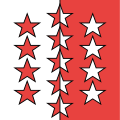









![Flag of the Chief of Staff of the Royal Italian Army[citation needed]](http://upload.wikimedia.org/wikipedia/commons/thumb/1/1f/Flag_of_the_chief_of_staff_of_the_Regio_Esercito.svg/120px-Flag_of_the_chief_of_staff_of_the_Regio_Esercito.svg.png)









